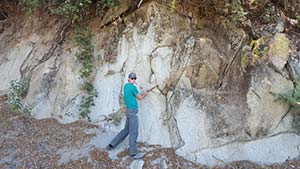
Contact Us
Institutional Communications
Bureau of Mines Building, Room 137
Laramie, WY 82071
Phone: (307) 766-2929
Email: cbaldwin@uwyo.edu
UW Receives NSF Grant to Study Connections Among Bedrock, Water and Life at Earths Surface
Published September 01, 2020

UW graduate student Russell Callahan inspects weathered bedrock exposed in a roadcut
in the Sierra Nevada, a mountain range in California, which is one of seven sites
to be studied under a $5.33 million NSF grant. Pore space in this material, known
as saprolite, is a vital reservoir of water for mountain ecosystems. Saprolite lies
between topsoil at the surface and unweathered bedrock at depth. Callahan will serve
as a postdoctoral associate on the project. (Cliff Riebe Photo)
Thanks to a $5.33 million National Science Foundation (NSF) grant, researchers from the University of Wyoming and eight other universities will focus on connections among rock, water and life at Earth’s surface.
Specifically, the five-year grant will help researchers define the “critical zone,” which refers to the Earth’s near-surface layer from treetop to bedrock.
“This project seeks to improve understanding of how weathering of rock beneath Earth's land surface influences subsurface water storage and flow, erosion of soil at the surface and the productivity of forests that are rooted in the weathered rock,” says Cliff Riebe, a professor in the UW Department of Geology and Geophysics. “Additionally, we seek a better understanding of how these processes (water flow, erosion and forest productivity) also influence weathering of rock at depth. It’s a complex system, and there are a number of exciting feedbacks that have remained poorly understood by scientists up until now because the subsurface is difficult to study. It has remained largely hidden beneath our feet.”
Riebe will serve as the grant’s principal investigator (PI) for UW, which received $1.63 million of the overall amount. His co-PIs at UW are Brad Carr, an associate research scientist in geology and geophysics, and director of the UW Near-Surface Geophysics Instrument Center; and Dario Grana, an associate professor of geology and geophysics.
The grant, awarded through NSF’s Critical-Zone Collaborative Network program, begins Sept. 1 (today) and runs through Aug. 31, 2025.
Other institutions involved with the grant are Clemson University; Colorado School of Mines; Concordia University in Quebec, Canada; Dickinson College; Johns Hopkins University; University of Minnesota; Virginia Tech University; and the University of California-Los Angeles.
Of the critical zone, Riebe says, “It’s basically Earth’s skin, where water, rock and life meet in a dynamic interplay that creates and maintains a substrate for life at Earth’s surface.”
The multi-institutional and multidisciplinary work on the deep critical zone will take place at seven sites spanning a wide range of climatic conditions across the continental U.S. These will range from a subtropical site in the South Carolina Piedmont to a set of hot, dry sites -- the San Jacinto and San Gabriel mountains -- located in Southern California. Other sites to be studied under the grant include the Laramie Range in Wyoming, the Colorado Front Range and a site in Maryland near Baltimore.
The project team will unite the disciplines of geology, biology and hydrology, combining direct sampling of subsurface materials via drilling and borehole logging with noninvasive, indirect imaging techniques. These techniques are analogous to methods used in modern medicine to image the human body, Riebe says.
“As the basis for the life that flourishes around us, the critical zone is important to understand, especially in how it is likely to respond as climate changes and land use intensifies over the coming decades,” Riebe explains. “In particular, our work should help improve management of forests and water resources by improving understanding of how deep critical zone processes influence forest ecosystem response to drought.”
The work also has some broader impacts. Because the critical zone is so tangible, there is a lot of potential to connect the science to everyday people and their concerns, Riebe says.
To help realize this potential, the project will first focus on communication training for the project team, and then undertake an outreach and engagement program with the theme of “Bringing the Critical Zone to Educators and Students.” Riebe says the program will include a new set of interactive 3D visualizations based on extensive imaging and measurements of roadcuts and quarries that dissect the critical zone.
“This platform, called the Virtual Critical Zone, will broaden access to science to anyone on a computer, providing educators with a new tool for teaching about the critical zone in distance learning and classroom settings alike,” Riebe says. “This is especially relevant with COVID-19 keeping everyone in lockdown.”
The project also will include hands-on programs for high school teachers and students, with experiential training for teachers and summer camps for students. All activities will support diversity and inclusion in critical zone science through intentional recruiting and outreach, including a teacher training program that targets underrepresented minorities in urban areas -- Baltimore, Denver and Los Angeles -- and first-generation and Native American populations in rural areas. These are rural Pennsylvania, South Carolina, southwest Virginia and Wyoming.
Contact Us
Institutional Communications
Bureau of Mines Building, Room 137
Laramie, WY 82071
Phone: (307) 766-2929
Email: cbaldwin@uwyo.edu
